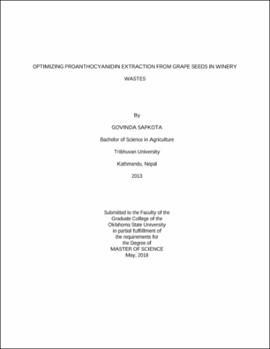| dc.contributor.advisor | Maness, Niels | |
| dc.contributor.author | Sapkota, Govinda | |
| dc.date.accessioned | 2021-08-30T15:49:59Z | |
| dc.date.available | 2021-08-30T15:49:59Z | |
| dc.date.issued | 2018-05 | |
| dc.identifier.uri | https://hdl.handle.net/11244/330753 | |
| dc.description.abstract | Grape seeds have been reported to be a good source of phenolic compounds accounting for 5% to 8% of total seed weight on a dry basis. There is not an established optimum procedure for phenolics extraction. The main objective of this study was to optimize extraction conditions, and then develop a partial extraction protocol, for total phenolic content (TPC) and proanthocyanidins (PA) of grape seeds and seed press cake from three different Oklahoma grown grape varieties ('Merlot', 'Cabernet Sauvignon' and 'Sangiovese'). The influence of different extraction factors: solvents, extraction time and pH of extraction solvents on TPC and PA extraction yield were assessed. Ultrasound-assisted extraction was also evaluated in terms of its capacity to increase the solvent potential of acidified water. Quantification of TPC and PA was done using a Folin-Ciocalteau spectrophotometric micro method and vanillin colorimetric method, respectively. Solvents adjusted at pH 2 favored TPC and PA extraction yield compared to pH 3 with most solvents. Proanthocyanidin extraction yield was probably insensitive to pH with 80% acetone and water as extraction solvents. Extraction time of 6 h was probably needed for maximum recovery of TPC from grape seeds and press cake, whereas PA yield might not increase with extraction time above 3 h. The optimal solvent for TPC from both seed and press cake appeared to be 70% ethanol at pH 2, while PA extraction was mostly favored by 80% acetone adjusted at pH 2. For 6 h of extraction, water at pH 2 recovered about 20% of TPC compared to 70% ethanol at pH 2 and about 35% of PA compared to 80% acetone at pH 2. Ultrasound-assisted extraction with water significantly reduced TPC and PA extraction time to 10 minutes and increased TPC and PA recovery about 10% compared to conventional extraction with water for 1 h. Using optimum extraction conditions TPC ranged from 8.3% to 9.4% in seeds and 8.4% to 12.1% in press cake and PA ranged from 4.3% to 6.8% in seeds and 4.1% to 5.6% in press cake on a dry, oil-free basis. | |
| dc.format | application/pdf | |
| dc.language | en_US | |
| dc.rights | Copyright is held by the author who has granted the Oklahoma State University Library the non-exclusive right to share this material in its institutional repository. Contact Digital Library Services at lib-dls@okstate.edu or 405-744-9161 for the permission policy on the use, reproduction or distribution of this material. | |
| dc.title | Optimizing proanthocyanidin extraction from grape seeds in winery wastes | |
| dc.contributor.committeeMember | Dunn, Bruce | |
| dc.contributor.committeeMember | McGlynn, William | |
| osu.filename | Sapkota_okstate_0664M_15592.pdf | |
| osu.accesstype | Open Access | |
| dc.type.genre | Thesis | |
| dc.type.material | Text | |
| dc.subject.keywords | cake | |
| dc.subject.keywords | colorimetric | |
| dc.subject.keywords | conventional | |
| dc.subject.keywords | proanthocyanidin | |
| dc.subject.keywords | ultrasound | |
| thesis.degree.discipline | Horticulture | |
| thesis.degree.grantor | Oklahoma State University | |
